Spain > Mallorca
Overview
Overview
The island of Mallorca (Majorca), off the east coast of Spain, is the largest in the Balearic Island group, which collectively forms one of the most popular beach holiday destinations in the Mediterranean, if not the world.
Mallorca took off as a tourist paradise in the 1960s, when a development boom spawned the building of hundreds of high-rise hotels, apartment blocks, and shopping centres that now line most of the island's coast.
The capital, Palma, still retains some of its historical flavour, sporting grand mansions and a magnificent Gothic cathedral in its bustling old centre. The northwest coast, too, still offers some secluded coves below the peaks of the Serra de Tramuntana mountain range, and several quaint old towns and villages still untouched by the commercial development common on the island.
If travellers visit Mallorca for sun and fun on the beautiful beaches, as most people do, it is worth heading off for a tour of the island by car, or even bicycle, to discover the romantic fishing villages, historic monasteries, monuments, museums, and spectacular landscapes secluded from the hubbub. The interior is largely the preserve of a thriving agricultural community, dotted with windmills, as well as olive and almond trees.
Palma de Mallorca has the island's international airport and is the main ferry terminus, receiving ferries from Valencia and Barcelona on the mainland. It is also the hub of the extensive transport system that covers Mallorca, with bus services linking all main settlements, and train lines to Inca and the scenic tourist train to Soller.
The best way to get around is by car and there are several rental agencies in Palma, but in high season reservations need to be made in advance. Everything on the island is within three hours drive from the capital.
Nightlife
Though not as raucous as its Balearic neighbour Ibiza, Mallorca is still famed for its nightlife, most of which is centred around its holiday resort towns. Of these, Magaluf is the most vibrant, closely followed by el Arenal and Palma.
From raging bars to quieter pubs and tavernas, Magaluf has got it all. The resort's infamous Punta Ballena strip is literally overrun by partygoers in the summer time, wending their merry way from one seething watering hole to another. The ever-popular BCM Planet Dance can accommodate up to 5,000 people and regularly features big-name DJs behind the decks. There are many other popular clubs and dance and live music venues as well; while those planning a bachelor or bachelorette party in Mallorca should head to Dorado Night City on the edge of Magaluf, where much of the entertainment has an erotic edge to it.
Some of the most popular clubs in el Arenal include Woody's Bar, Uforia, Riu Palace and Zorbas, a double-storey disco that's chiefly popular amongst 20-30 year olds. In Palma itself, Pacha Mallorca has a big reputation (and can charge a hefty admission during summer), while Tito's, located on the seafront near Paseo Maritimo, is one of the more exclusive clubs in Mallorca. L'Havanna is good for Latin music and dancing, and Black Cat is the most popular gay bar on the island of Mallora.
Meanwhile, Paguera, Puerto Pollensa, Cala Millor, S'Illot and Sa Coma are all quieter resorts, which cater more to families. Visitors shouldn't expect much pulsating nightlife in these areas, as the evening's entertainment will more likely consist of a pleasant paseo (stroll) along the waterfront, before heading out to a tavern for a few quiet drinks and a relaxed meal.
Shopping
Palma de Mallorca is the centre of the shopping scene with sprawling malls, shop-lined streets, and daily stalls and markets where tablecloths or leather goods can be scooped up for a song, with a bit of haggling.
The main shopping street in Cala d'Or, Avinguda Tagomago, is a bustling flurry of souvenir shops, chic boutiques, leather shops and galleries. The stretch of shops in Pageura known as El Bulevar features supermarkets, clothing shops and souvenir shops, while the pedestrian promenades on Cala Millor and Magalluf's seafronts are jam-packed with stalls selling buckets and spades and tourist trinkets.
Markets are a great place to shop on the island of Mallorca and the Monday market in Calvia is the place to go for porcelain, jewellery and leather goods, as are the Wednesday markets in Andratx in Palma and Thursday's Inca market, but brush up on bargaining skills. Near Cala Millor, the Friday markets in Son Servera and Monday markets in Monacor are a great place to find unique goods and fresh produce as well as souvenirs such as espadrilles, embroidery and basketwork. The weekly Sunday market in Pollensa's old town is one of the liveliest and definitely worth a wander for everything from local crafts and olive wood carvings to ceramics and lace.
Sightseeing & Attractions
Sightseeing
Mallorca is a famous beach resort destination and the main attractions for many visitors are the lovely beaches and beautiful jewel-coloured water. Sun-worshippers will adore the endless stretches of coastline that feature fantastic beaches, with Palma Nova, Illetes, and Es Trenc, on the southeast coast being the most popular.
Mallorca is, however, also steeped in a rich and wonderful Mediterranean history and has some fascinating attractions that will appeal to all kinds of travellers and provide an intriguing insight into the history of the island.
Visitors will love the Catedral El Seo, Castell del Bellver and the Museo d'Art Espanyol Contemporani in Palma, while the Banys Arabs, the only surviving Moorish building in the city, is a fascinating attraction.
History buffs should take a trip to Santa Margalida, which boasts more than 150 archaeological sites, to visit the Son Real Necropolis, where Phoenicians were buried from the Iron Age to Roman times. Fascinating historic towns such as Valldemossa, Lluc, Pollensa, Arta and Alcudia leave tourists spoilt for choice.
Those looking for a taste of the outdoors as well as some history will love the Castell d'Alaro, Mallorca's most popular hiking trail, beginning from the town of Alaro and winding up to a ruined 15th-century castle and hilltop chapel and offering breathtaking views over the island and sea. The Mallorca Caves are also worth a visit for nature lovers, with impressive underground lakes, stalactites, and stalagmites.
Kids Attractions
Many travellers associate the island with wild parties and package holidays for young tourists hell bent on having a good time, but Mallorca's quieter resorts are fantastic places for families with children to take a summer holiday, and the combination of great tourist amenities and historic sightseeing will keep everybody entertained and happy.
Puerto Pollensa and Cala d'Or are quiet and the beaches uncrowded, a great location for the kids to build sand castles and play with buckets and spades, but visitors should remember to pack the sunscreen, as the temperatures in summer months can be searing. El Arenal boasts an enormous waterpark, as do Alcudia and Magalluf. Parents can also take the kids go-karting in Magalluf, or enjoy a family horse-riding trip to see the island from Alcudia. A trip to Marineland, in Costa d'en Blanes, to watch the dolphins and sea lions perform, or be mesmerised by the sharks in the aquarium, is a must. On days when outdoor activities are not an option for kids on holiday in Mallorca, many of the hotels feature kids clubs, or children's indoor playgrounds, and there are other options such as Mallorca Aquarium in Porto Cristo. Of course, the city of Palma has many attractions for a rainy day, but those wanting to stick to their chosen resort certainly shouldn't be bored either.
Attractions
La Seo Cathedral
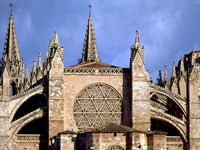
Palma's magnificent Catalonian Gothic cathedral is a landmark of the city, standing in the old town overlooking the ocean. The cathedral is actually called the Cathedral of the Saviour (Catedral del Salvador) but is situated on the Plaza de la Seo and is commonly referred to as La Seo. The cathedral forms part of a UNESCO World Heritage Site. The cathedral was built on the site of an existing ancient mosque and ancient Roman forum, and construction on the Romanesque Cathedral began in 1140. There have been numerous rebuilds, additions, and renovations since then, including an extensive restoration in the second half of the 20th century, when Roman and Muslim remnants were excavated and exposed.
Palau de l'Almudaina
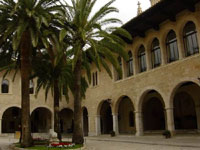
Opposite the cathedral in Palma stands an austere fortress palace that was erected by the Moors and later became the residence of the kings of Mallorca. The Moors built the fortress in 1281 and it was converted into a royal residence at the end of the 13th century, but evidence suggests that the Moors themselves built on an existing Roman fort. The palace is still officially a royal residence, although very seldom occupied, and is occasionally used for royal functions and events. Inside, most rooms and corridors are bare, but there are some beautiful Flemish Gobelin tapestries on display as well as a few antiques, art works and suits of armour.
Castell de Bellver
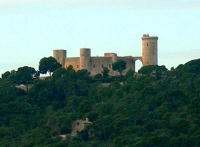
Built in the 14th century and surrounded by a double moat, this round hilltop castle was the summer residence of the kings of Mallorca. While once serving as a prison, it today contains Palma's Municipal Museum displaying archaeological artefacts and models of excavations. The unusual castle sits atop a lovely park area and its highlights include spectacular views and photo opportunities. Visitors can explore a series of chambers upstairs above the museum below, and should not miss the prisoner's graffiti etched into the stonework, visible if guests climb up to the roof. The Bellver Castle is on the route of the Palma City open-top sightseeing buses, but the walk up through the forest from Placa Gomilla is pleasant and not too strenuous.
Banys Arabs
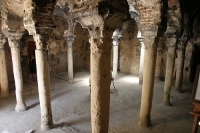
The only surviving Moorish building in Palma is the bathhouse of Banys Arabs, located in the city's medieval quarter. It contains an elegant horseshoe-arched dome chamber supported by 12 columns, fronted by a lovely little garden with picnic tables. Although this is a small attraction, basically consisting of two empty chambers (hence the low admission cost), the old architecture is graceful and photographers should enjoy capturing the romantically dilapidated walls and columns. The baths are worth visiting to get some impression of the character of the old city, as they are sadly all that remains.
Valldemossa
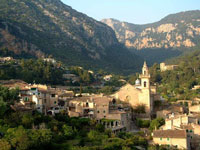
In 1838, Frederic Chopin arrived in the small town of Valldemossa with his lover, George Sand, to stay in a former monk's cell in the Cartoixa Reial monastery and carry on their affair away from the eyes of Paris. The shocked locals shunned the sickly Chopin and Sand, and the couple were so unhappy that their relationship never recovered from the wet, windy and miserable winter in the monastery. Today the cells occupied by the lovers are open to visitors. The library and old pharmacy can also be visited and there is a small art museum with works by Picasso, Miro, and Juli Ramis. Valldemossa is one of the prettiest villages in Mallorca: it is quiet and traditional, with narrow cobbled streets and a backdrop of forested hills.
Santuari de Lluc
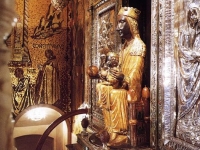
About 20 miles (32km) beyond Soller, after a drive through the Serra de Tramuntana in the north of the island, is the remote mountain village of Lluc, in a valley that has been an important place of pilgrimage since the 13th century. Lluc became Mallorca's most sacred site when a shepherd boy discovered a dark wooden statue of the Virgin in a cleft in the rock. The miraculous statue somehow returned to its cave three times after being placed in the local church. Now the statue, known as La Moreneta, has been encrusted with precious stones and resides in its own chapel, receiving pilgrims and tourists who come to pay homage each day.
Aqualand Mallorca
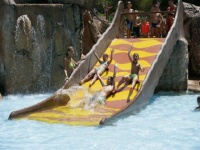
Aqualand is one place that is not to be missed by families on holiday in Mallorca. Children of all ages and parents alike will have a grand time splashing in the pools, riding the slides, floating on tubes, a mini water park for the little ones, or jumping in the wave pools. Those who don't relish excitement can enjoy the lazy river or the Jacuzzis, and the whole family will enjoy the surf beach and group rides. There are lockers and sun loungers available to rent for a small extra charge and there are various options for food and refreshments in the park. Benches and beach areas provide space for relaxation in between the thrills and spills.
Katmandu Park
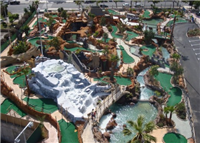
Katmandu Park is a theme park and mini-golf complex that proves wildly popular amongst younger visitors to Magaluf. Featuring cutting-edge technology, The House of Katmandu provides a thrilling and interactive haunted house experience for youngsters; The Asylum, aimed at older visitors (12 years and older), takes passengers on a scary journey through an abandoned mental asylum; the interactive motion ride Desperado is a comical cowboy gun slinging experience; and there is a 4D cinema to enjoy. The 36-hole (two 18-hole courses) Expedition Golf area of the theme park is hugely impressive, featuring fun and challenging courses, elaborately ornamented and themed, that even adults will find tough to master.
Castell d'Alaro
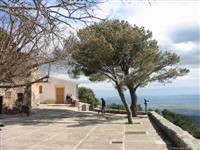
Mallorca's most popular hiking trail is the climb from the town of Alaro up to a ruined castle and hilltop chapel, which offers panoramic views of the sea and plains as far as Palma. From Alaro the walk takes about two hours to complete depending on fitness levels. A castle has stood on this site since Moorish times and the fortress was once so impregnable that the Moors managed to hold out against the Christian conquest for two years. Later, in 1285, Mallorcan independence fighters tried to defend the castle against Alfonso III of Aragon, but they were defeated and burned alive for their impudence. The castle ruins now visible on the hilltop date from the 15th century and dominate the landscape. They seem to grow out of the rock and are rather romantic and picturesque, fuelling the imagination.
Climate
Mallorca, or Majorca, enjoys a typical Mediterranean climate, with hot, dry summers and mild winters. The island has an ideal climate for holidaymakers with little rain and average temperatures usually kept comfortably below 86ºF (30ºC) even in mid-summer. Temperatures remain warm in the spring and autumn and even in winter rarely drop much below 50ºF (10ºC). Water temperatures range from 64ºF (18ºC) in May to 79ºF (26ºC) in August making Mallorca ideal for water sports and ensuring that swimming is possible throughout spring and autumn as well as summer.
Mallorca doesn't get much rain, but autumn is the wettest season, with 40 percent of rain falling between September and November. There is also some rain in spring, between March and May, and in winter, between December and February. Outside of autumn rainfall is usually sporadic and light and shouldn't be too disruptive to holiday plans.
Summer, between June and August, is the peak tourist season in Mallorca and the best time to visit. The island is also pleasant to visit during the mild spring and autumn seasons, especially for those who prefer to avoid the crowds, although some rain is possible. During winter some of the restaurants and amenities at the resorts may close.
| Jan | Feb | Mar | Apr | May | Jun | Jul | Aug | Sep | Oct | Nov | Dec | |
|---|---|---|---|---|---|---|---|---|---|---|---|---|
| Rain (cm) | 39 | 34 | 37 | 35 | 34 | 20 | 8 | 18 | 51 | 76 | 53 | 54 |
| Average Temperature (°C) | 10 | 10 | 12 | 14 | 18 | 22 | 25 | 25 | 23 | 19 | 14 | 11 |
| Min Temperature (°C) | 8.3 | 8.4 | 9.5 | 11.3 | 14.7 | 18.4 | 21.3 | 22.2 | 19.8 | 16.1 | 12.1 | 9.7 |
| Max Temperature (°C) | 15.2 | 15.7 | 17.1 | 18.7 | 22.1 | 25.9 | 29.9 | 30.5 | 28.1 | 23.4 | 19.2 | 16.5 |
| Average Temperature (°F) | 50 | 51 | 54 | 58 | 64 | 71 | 76 | 77 | 73 | 66 | 58 | 52 |
| Min Temperature (°F) | 46.9 | 47.3 | 49.1 | 52.3 | 58.5 | 65.1 | 70.3 | 72 | 67.6 | 61 | 53.8 | 49.5 |
| Max Temperature (°F) | 59.4 | 60.3 | 62.8 | 65.7 | 71.8 | 78.6 | 85.8 | 86.9 | 82.6 | 74.1 | 66.6 | 61.7 |
Palma de Mallorca Airport
Mallorca’s airport is situated five miles (8km) east of Palma.
Tel: +34 971 789 000, +34 902 404 704.
www.aena.es
Facilities
Facilities at the airport include ATMs, bureaux de change, shops, bars and restaurants, a post office, first aid, baby rooms, police, lost luggage and a children's play area. Disabled facilities are good; those with special needs should contact their airline in advance.
Car Parking
Facilities at the airport include ATMs, bureaux de change, shops, bars and restaurants, a post office, first aid, baby rooms, police, lost luggage and a children's play area. Disabled facilities are good; those with special needs should contact their airline in advance.
Car Rental
Several car hire companies are represented at the airport including Avis, Europcar, Sixt and Hertz.
Taxis
Taxis are available outside the Arrivals hall.
Transfer City
Most tour operators organise transport from the airport to hotels. Otherwise, there are two buses that connect the airport to Palma and other major towns and resorts on the island. Buses Route 1 and Route 21 operate between the areas outside Arrivals and Departures and cost about €5 for a one-way trip to Palma for non-residents.
See map biggerGetting out and about

Hidropark Alcudia - the only water park in the north of Majorca from £21 per person
Hidropark is the only water park in the north of Majorca, and boasts a host of great attractions which not only includes the usual water slides, and pools, but guests can also enjoy paintball. mini golf, giant floating balls and more!

Pirates Adventure Dinner from £34 per person
A UNIQUE show like you have never seen before. This story starts in 1649AD within a true swashbuckling Caribbean themed theatre; Sir Henry Morgan and his brave captains will defend their treasure from the evil and mutinous Jacques Laffitte.









